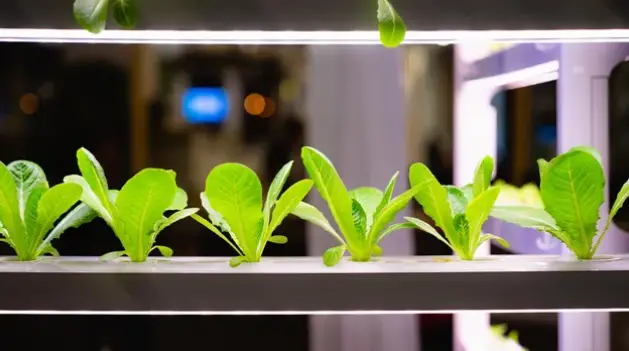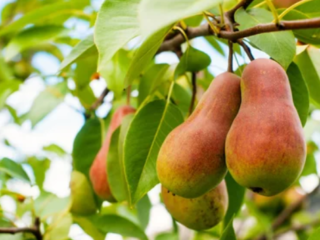many people have considered using Led to start their seed indoors but don’t have a clue which light to use or where to start.
However in this post, we will go over why LED light is good for seed starting, which is best, and the pros and cons of using different types of LED Lights.
But first, let’s go over some basic introduction to LED Lights.
When starting a garden from seeds is can be a fun and rewarding process, but it can also be a bit challenging.
One key factor that can make or break the success of your seedlings is the type of lighting they provide.
While natural sunlight is always the best option, out of all LED Lights it may not be feasible or available year-round, especially if you live in a colder climate.
However, this is where grow lights come in.
Most grow lights are artificial lighting systems specifically designed to mimic the sunlight needed by plants to grow and thrive.
They come in a variety of shapes, sizes, and wavelengths, and can be used for everything from seed starting to full-fledged indoor gardens.
So, now we’ll be focusing specifically on using grow lights for seed starting, including the different types of grow lights available, how to choose the right one for your needs, and how to set up and use your grow lights to get the best results
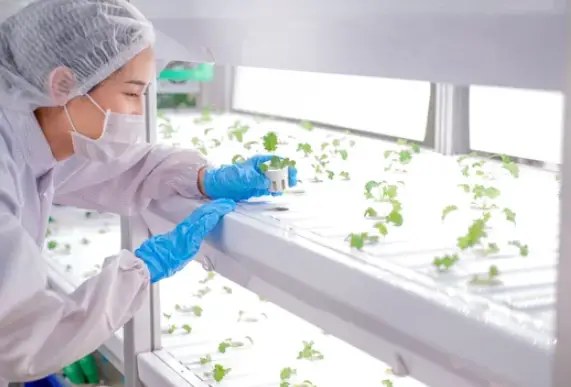
Types of Grow Lights
Did you know there are several different types of grow LED lights to choose from, and the right one for you will also depend on your specific needs and budget?
Here are a few of the most common types of grow lights:
Fluorescent lights:

Fluorescent grow lights are some of the most affordable options on the market.
They produce a softer, cooler light that is ideal for seedlings and smaller plants.
They are also energy-efficient and produce very little heat, making them a good choice for smaller spaces.
LED lights:
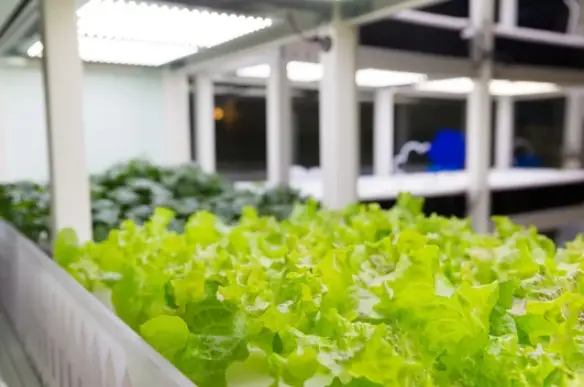
LED grow lights are becoming increasingly popular for growing seeds due to their energy efficiency and long lifespan.
These types of lights produce a brighter, more focused light than fluorescent lights, and are available in a variety of spectrums to suit different stages of plant growth.
They can be a bit pricier upfront, but they save on energy costs and replacement bulbs in the long run.
HID lights:
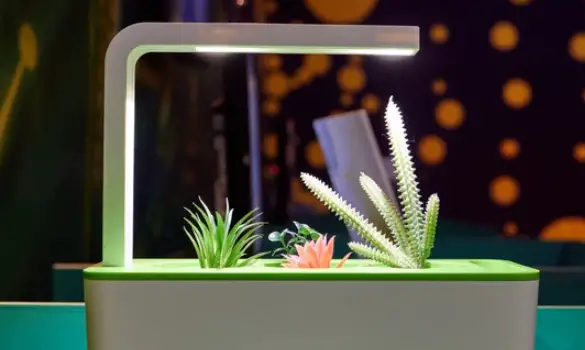
High-intensity discharge (HID) grow lights, such as metal halide and high-pressure sodium lights, are some of the most powerful options available.
They produce a lot of heat, so they are best suited for larger spaces or plants that require more intense light.
They can be a bit more expensive to operate due to their high energy consumption, but they are a good choice for plants that require a lot of light to thrive.
Choosing the Right Grow Light
When it comes to choosing the right grow light for your seedlings, there are a few key factors to consider:
Spectrum:
Different types of wavelengths of light are absorbed by plants in different ways, and certain spectrums are better suited for different stages of plant growth.
For seedlings, a spectrum that is rich in blue light is typically best, as it helps to encourage strong stem and leaf growth.
As your plants mature, they will benefit from a spectrum that is higher in red light, which helps to promote flowering and fruiting.
Intensity:
The intensity of your grow light is another important factor to consider.
Seedlings and small plants require a lower intensity of light, while larger plants and those in the flowering stage will need a higher intensity.
The intensity of your grow light is typically measured in lumens or watts.
Size and coverage:
The size and coverage of your grow light will depend on the size of your grow space and the number of plants you are growing.
It’s important to choose a grow light that is appropriately sized for your needs, as too much or too little light can affect the health and growth of your plants.
Price:
Of course, the price of your grow light is also an important factor to consider. There are grow lights available at a wide range of price points, so it’s important to find one that fits your budget while still providing the features and performance you need.
Setting Up Your Grow Light
So, once you’ve chosen the right to grow light for your needs, it’s time to set it up and get started.
Here are a few tips to help you get the most out of your grow light setup as follows:
Location:
You should always choose a location for your grow light that is close to an electrical outlet and make sure it is in a stable and secure place where it won’t be knocked over or damaged.
It’s also a great idea to choose a location that is easy to access, as you’ll need to be able to adjust the height of your grow light as your plants grow.
Height:
The height of your grow light is important as it will affect the intensity of the light that your plants receive.
Seedlings and small plants should be kept about 2-4 inches below the grow light, while larger plants will benefit from a height of about 12 inches or more.
It’s important to adjust the height of your grow light as your plants grow to ensure they are getting the right amount of light.
Timing:
Most plants need a certain amount of light each day to grow properly, and this is known as the photoperiod.
For seedlings, a photoperiod of 14-16 hours per day is generally recommended.
You can use a timer to automate your grow light setup, or you can manually turn the lights on and off each day.
Watering:
Proper watering is crucial for the health and growth of your seedlings.
Be sure to check the soil moisture level regularly and water as needed, taking care not to overwater or allow the soil to dry out completely.
Using Your Grow Light
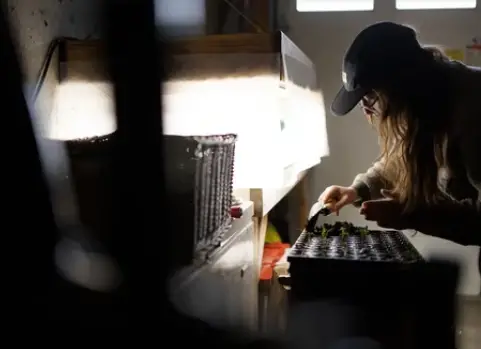
So, now that you have set up your LED grow light and have your seedlings ready to go, it’s time to get started.
Here are a few tips to help you use your grow light effectively:
Start with healthy seeds:
It’s important to start with healthy, high-quality seeds to give your seedlings the best chance of success.
Be sure to follow the seed packet instructions for planting and care, and you should also consider using a seed starter mix or propagator to provide the optimal environment for your seeds to germinate.
Monitor temperature and humidity:
The temperature and humidity in your growing space can have a big impact on the health and growth of your seedlings too.
Keep an eye on these levels and adjust as needed to ensure your plants are getting the optimal conditions they need to thrive.
Fertilize as needed:
As your seedlings grow and mature, they will benefit from balanced fertilization as well.
Consider following the recommendations on your fertilization product of choice, and be sure to use a fertilization schedule that is appropriate for your specific plant needs.
Pinch and prune as needed:
To encourage strong, healthy growth, it may be necessary to pinch or prune your seedlings as they grow.
This helps to promote bushier, more compact growth and can help your plants reach their full potential.
The Pros and Cons Of Using LED Lights For Seed Starting
Fluorescent Lights:
Pros:
- Affordable
- Energy-efficient
- Produce little heat
- Soft, cool light is suitable for seedlings
Cons:
- May not be powerful enough for larger plants or flowering stages
- Bulbs need to be replaced periodically
LED Lights:
Pros:
- Energy-efficient
- Long lifespan
- Available in a variety of spectrums
- The bright, focused light is suitable for all stages of plant growth
Cons:
- More expensive upfront
HID Lights:
Pros:
- Powerful light suitable for large plants or flowering stages
Cons:
- Produce a lot of heat
- Expensive to operate due to high energy consumption
Ultimately, the right growth light for you will depend on your specific needs and budget. Consider the pros and cons of each type of light and choose the one that best fits your needs.
Conclusion
Grow lights are a useful tool for starting seeds and growing plants indoors, and with a little bit of planning and care, you can use them to achieve great results.
However, by choosing the right grow light for your needs, setting it up properly, and using it effectively, you can create the perfect environment for your seedlings to thrive.
Whether you’re a seasoned gardener or a beginner, using grow lights can be a fun and rewarding way to start your garden from seed and enjoy the fruits of your labor all year round.

